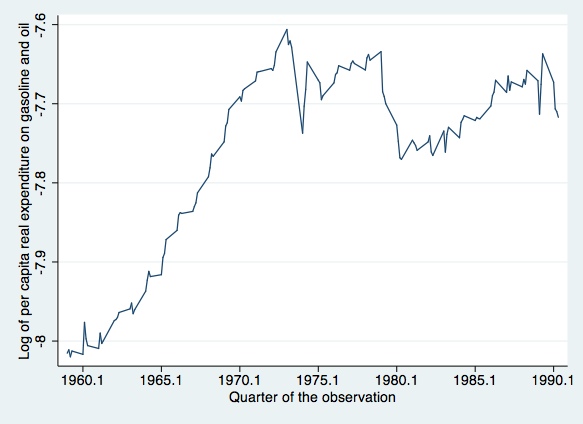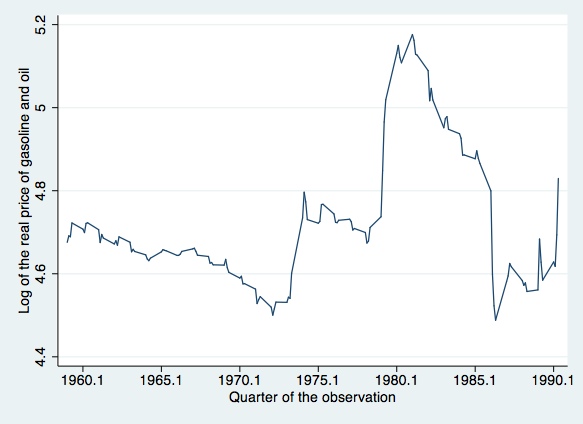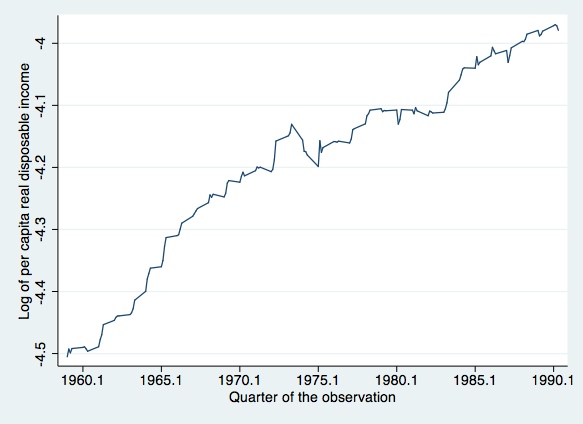e-TA 3: Introduction to Dynamic Models
Welcome to e-Tutorial, your on-line help to Econ508. This issue provides an introduction to dynamic models in Econometrics, and draws on Prof. Koenker's Lecture Note 3. The adopted philosophy is "learn by doing”: the material is intended to help you to solve the problem set 2 and to enhance your understanding of the topics.1
Data Set
The data set used in this tutorial was borrowed from Johnston and DiNardo's Econometric Methods (1997, 4th ed), but slightly adjusted for your needs. It is called AUTO2. You can download the data by visiting the Econ 508 web site (Data). As you will see, this adapted data set contains five series.
use AUTO2.dta, clear
describe obs: 128 AUTO2 adapted from Johnston and DiNardo, 1997
vars: 5 11 Sep 2002 12:22
size: 2,560
-----------------------------------------------------------------------------------------------------
storage display value
variable name type format label variable label
-----------------------------------------------------------------------------------------------------
quarter float %9.0g Quarter of the observation
gas float %9.0g Log of per capita real expenditure on gasoline and oil
price float %9.0g Log of the real price of gasoline and oil
income float %9.0g Log of per capita real disposable income
miles float %9.0g Log of miles per gallon
------------------------------------------------------------------------------------------------------
Sorted by:
Summarizing the data
A useful recommendation for practitioners of Econometrics is to summarize the data set you are going to work with. This provides a "big picture” of the variables and what you can expect from them. You can do that by as follows:
summarize Variable | Obs Mean Std. Dev. Min Max
-------------+--------------------------------------------------------
quarter | 128 1974.75 9.270052 1959.1 1990.4
gas | 128 -7.763027 .1201866 -8.019878 -7.606151
price | 128 4.723974 .1658683 4.488154 5.176053
income | 128 -4.19457 .153558 -4.50524 -3.969884
miles | 128 2.712568 .1348134 2.583997 3.035914
Even better, you can ask for the details of each variable:
summarize, detail
Quarter of the observation
-------------------------------------------------------------
Percentiles Smallest
1% 1959.2 1959.1
5% 1960.3 1959.2
10% 1962.1 1959.3 Obs 128
25% 1966.75 1959.4 Sum of Wgt. 128
50% 1974.75 Mean 1974.75
Largest Std. Dev. 9.270052
75% 1982.75 1990.1
90% 1987.4 1990.2 Variance 85.93386
95% 1989.2 1990.3 Skewness 1.81e-17
99% 1990.3 1990.4 Kurtosis 1.798007
Log of per capita real expenditure on gasoline and
oil
-------------------------------------------------------------
Percentiles Smallest
1% -8.016769 -8.019878
5% -8.005725 -8.016769
10% -7.974048 -8.015248 Obs 128
25% -7.836869 -8.012581 Sum of Wgt. 128
50% -7.719422 Mean -7.763027
Largest Std. Dev. .1201866
75% -7.671802 -7.628435
90% -7.64901 -7.625179 Variance .0144448
95% -7.636929 -7.620612 Skewness -.9293219
99% -7.620612 -7.606151 Kurtosis 2.503103
Log of the real price of gasoline and oil
-------------------------------------------------------------
Percentiles Smallest
1% 4.500299 4.488154
5% 4.531126 4.500299
10% 4.557322 4.515703 Obs 128
25% 4.621168 4.51949 Sum of Wgt. 128
50% 4.675815 Mean 4.723974
Largest Std. Dev. .1658683
75% 4.767021 5.130968
90% 5.016708 5.149823 Variance .0275123
95% 5.121161 5.162098 Skewness 1.180383
99% 5.162098 5.176053 Kurtosis 3.591608
Log of per capita real disposable income
-------------------------------------------------------------
Percentiles Smallest
1% -4.498873 -4.50524
5% -4.490103 -4.498873
10% -4.446543 -4.496271 Obs 128
25% -4.284298 -4.492739 Sum of Wgt. 128
50% -4.158388 Mean -4.19457
Largest Std. Dev. .153558
75% -4.105482 -3.978981
90% -4.006467 -3.971754 Variance .0235801
95% -3.985354 -3.971611 Skewness -.55278
99% -3.971611 -3.969884 Kurtosis 2.312228
Log of miles per gallon
-------------------------------------------------------------
Percentiles Smallest
1% 2.585882 2.583997
5% 2.590767 2.585882
10% 2.596746 2.586259 Obs 128
25% 2.613006 2.587764 Sum of Wgt. 128
50% 2.64715 Mean 2.712568
Largest Std. Dev. .1348134
75% 2.812479 3.013695
90% 2.950735 3.021156 Variance .0181746
95% 2.995482 3.028562 Skewness 1.069017
99% 3.028562 3.035914 Kurtosis 2.68393
Working with Time Series in Stata
The next step is to create the variables you will need to run dynamic models. Here you have two strategies:
(i) generate lags and differences using the command gen (explained in class)
(ii) convert your data set in time series, using the command tsset
Usually the strategy (ii) saves you time during the model selection
process. Hence, following (ii), you need to generate a variable
corresponding to the time period of each observation (which can not be
“quarter” because it contains non-integer values):
gen t = _n
label variable t "Integer time period" tsset t time variable: t, 1 to 128
delta: 1 unit
Now you are ready to work with time series. The main operators you will need are:
| 1-period lag: |
y(t-1) |
type: |
L.y |
| 2-period lag: |
y(t-2) |
type: | L2.y |
| ... |
|||
| 1-period lead: |
y(t+1) |
type: | F.y |
| 2-period lead: |
y(t+2) |
type: | F2.y |
| ... |
| Difference: |
y(t) - y(t-1) |
type: | D.y |
| Differerence of difference: |
[y(t)-y(t-1)] - [y(t-1)-y(t-2)] |
type: | D2.y |
| ... |
|||
| Seasonal difference: |
y(t) - y(t-1) |
type: | S.y |
| Lag-2 Seasonal difference |
y(t) - y(t-1) |
type: | S2.y |
| ... |
Graphing Time Series
Next we will try to replicate some of Johnston and DiNardo's (1997, p. 267) graphical results
line gas quarter, c(l) s(.) sort xlabel(1960.1 (5) 1990.1)
line pricequarter, c(l) s(.) sort xlabel(1960.1 (5) 1990.1)

line incomequarter, c(l) s(.) sort xlabel(1960.1 (5) 1990.1)

Running Dynamic Models
Next let’s run a typical dynamic model (Johnston and DiNardo, 1997, p. 269, Table 8.5):
regress gas price L.price L2.price L3.price L4.price L5.price income L.income
L2.income L3.income L4.income L5.income L.gas L2.gas L3.gas L4.gas L5.gas
Source | SS df MS Number of obs = 123
-------------+------------------------------ F( 17, 105) = 383.71
Model | 1.47998066 17 .087057686 Prob > F = 0.0000
Residual | .023823131 105 .000226887 R-squared = 0.9842
-------------+------------------------------ Adj R-squared = 0.9816
Total | 1.50380379 122 .012326261 Root MSE = .01506
------------------------------------------------------------------------------
gas | Coef. Std. Err. t P>|t| [95% Conf. Interval]
-------------+----------------------------------------------------------------
price |
--. | -.2676449 .0378744 -7.07 0.000 -.3427428 -.192547
L1. | .2628672 .0692914 3.79 0.000 .1254751 .4002592
L2. | -.0174063 .0754139 -0.23 0.818 -.1669381 .1321256
L3. | -.0720921 .0773891 -0.93 0.354 -.2255404 .0813562
L4. | .0143968 .0772103 0.19 0.852 -.1386968 .1674905
L5. | .0582077 .0463403 1.26 0.212 -.0336765 .1500919
|
income |
--. | .2927731 .1588226 1.84 0.068 -.0221427 .607689
L1. | -.1621984 .220227 -0.74 0.463 -.5988679 .2744712
L2. | -.0492554 .2143709 -0.23 0.819 -.4743133 .3758024
L3. | .0104172 .2131308 0.05 0.961 -.4121818 .4330161
L4. | .084901 .2101309 0.40 0.687 -.3317496 .5015517
L5. | -.1989616 .1531175 -1.30 0.197 -.5025654 .1046422
|
gas |
L1. | .6605733 .096063 6.88 0.000 .4700981 .8510485
L2. | .0670148 .1145346 0.59 0.560 -.1600861 .2941157
L3. | -.0235803 .1170941 -0.20 0.841 -.2557564 .2085957
L4. | .1321968 .119014 1.11 0.269 -.103786 .3681797
L5. | .1631249 .1013842 1.61 0.111 -.0379011 .364151
|
_cons | .0055429 .1260436 0.04 0.965 -.2443782 .2554639
------------------------------------------------------------------------------
Long-run Elasticities
Suppose you wish to compute the long run income and price elasticities. Assuming that in the long-run the variables converge to their respective steady-state values (represented by "e”):
\[gas_{t}=gas_{t-1}=gas_{t-2}=...=gas_{e}\]
\[price_{t}=price_{t-1}=price_{t-2}=...=price_{e} \] \[income(t)=income(t-1)=income(t-2)=...=income_{e}, \]
and recalling that all variables are already in logs, you then just have to apply this steady state condition, reparameterize the model, and calculate the elasticities:
\[ \frac{d (gas(e))}{ d (income(e))}= \text{long run income elasticity} \] \[ \frac{d (gas(e))}{d (price(e))} = \text{long run price elasticity } \]
After that you can compare the long-run elasticities of the (reparameterized) dynamic model with the elasticities provided by the static version of this log-linear regression:
regress gas price income
Source | SS df MS Number of obs = 128
-------------+------------------------------ F( 2, 125) = 218.86
Model | 1.42698222 2 .713491108 Prob > F = 0.0000
Residual | .407508656 125 .003260069 R-squared = 0.7779
-------------+------------------------------ Adj R-squared = 0.7743
Total | 1.83449087 127 .01444481 Root MSE = .0571
------------------------------------------------------------------------------
gas | Coef. Std. Err. t P>|t| [95% Conf. Interval]
-------------+----------------------------------------------------------------
price | -.1502843 .0312311 -4.81 0.000 -.2120945 -.0884742
income | .7056134 .0337348 20.92 0.000 .6388481 .7723787
_cons | -4.093342 .2247555 -18.21 0.000 -4.538161 -3.648523
------------------------------------------------------------------------------
I suggest you to provide a little table comparing those results, and write your comments about how the elasticities differ from the static to the dynamic model.
In the light of the problem set, I suggest you to compute not only the point estimate of the elasticities, but also their confidence intervals. In the static model, confidence intervals are obtained directly from the regression output. But for the dynamic model, the elasticities are represented by a non-linear function of the parameters. In that case, you need to find confidence intervals for the elasticities using Delta-method or Bootstrap techniques, which you will see in professor Koenker's Lecture Note 5 and we will address in a future e-TA.
Impulse Response Functions
Here I recommend to use the best dynamic model (following the Schwarz Information Criterion that you will see in e-Tutorial 5), and to compute impulse response functions using the formula on Prof. Koenker's Lecture Note 3, page 3.P.S.: Some authors propose alternative ways to calculate impulse response functions. One of them is to use partial derivatives (e.g., Enders, 1995, p.24), but such method has a drawback: it is quite easy to make a mistake when you have models with many lags and differences.
Usually it is expected that you account for a reasonable amount of response periods, depending on the structure of your data set. Usually we suggest a minimum of 40 (forty) response periods for quarterly data. Then you plot those responses along the respective time scale (t=0,1,2,3,...,40). This will generate the non-cumulative impulse response function. If you wish a cumulative impulse response function, at each new period t+i (i=1,2,3,...), you should add the effect to the previous shocks.
Please send comments to bottan2@illinois.edu or srmntbr2@illinois.edu